Abstract
N alpha-(N-acetylmuramyl-L-alanyl-D-isoglutamine)-N epsilon-stearoyl-L-lysine, a synthetic muramyl dipeptide analog, stimulated the production of the third component of complement (C3) in mice. The serum concentration of C3 was elevated significantly by subcutaneous treatment with a single dose (10 to 100 micrograms per mouse) of the adjuvant 24 h before assay of the serum. Thereafter, the concentration decreased gradually with time and returned to the normal level on day 4 to 5. Immunoelectrophoretic analysis of the serum revealed that the decrease in serum C3 could not be accounted for by the cleavage to C3a and C3b. By intermittent treatment with the adjuvant on every fifth day, a significant increase in serum C3 was repeated. However, no continuous retention of the serum level of C3 was established even during continuous treatment with the adjuvant once a day for 10 consecutive days. Instead, in this case, the level of C3 increased repeatedly at almost 5-day intervals.
Full text
PDF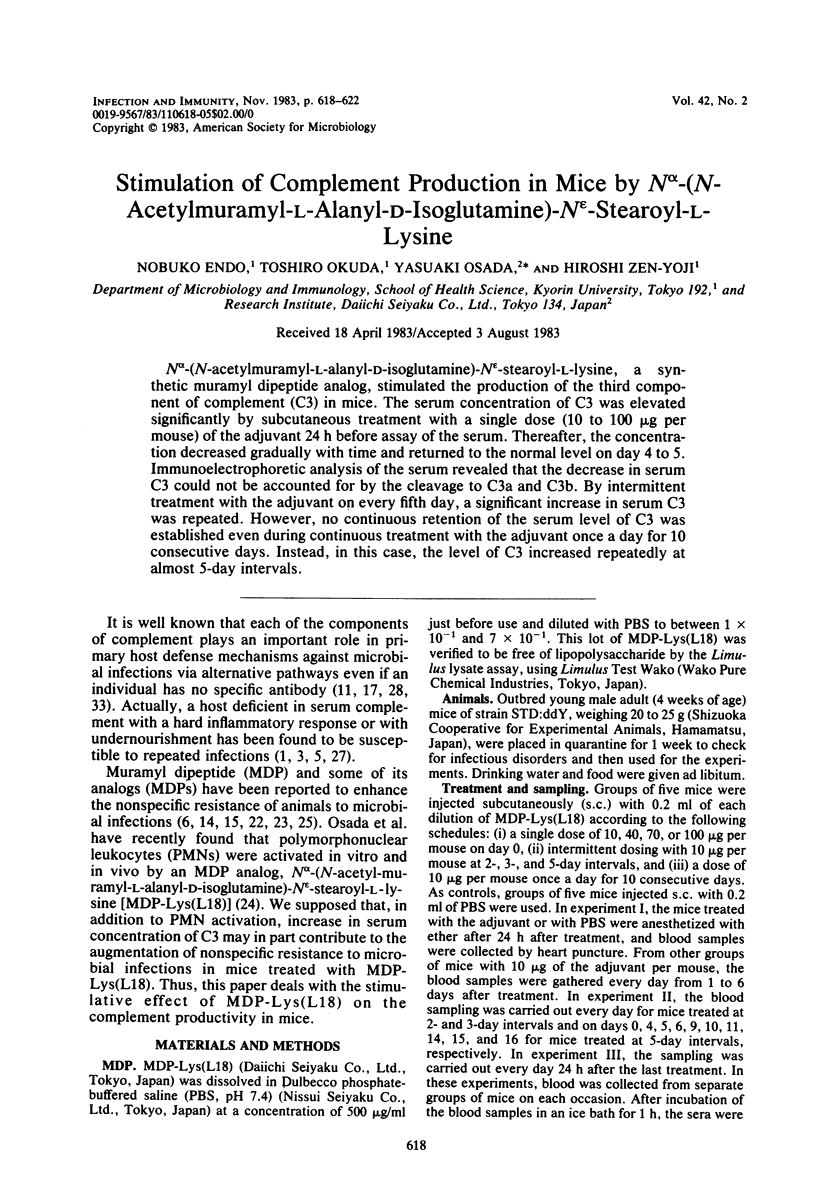
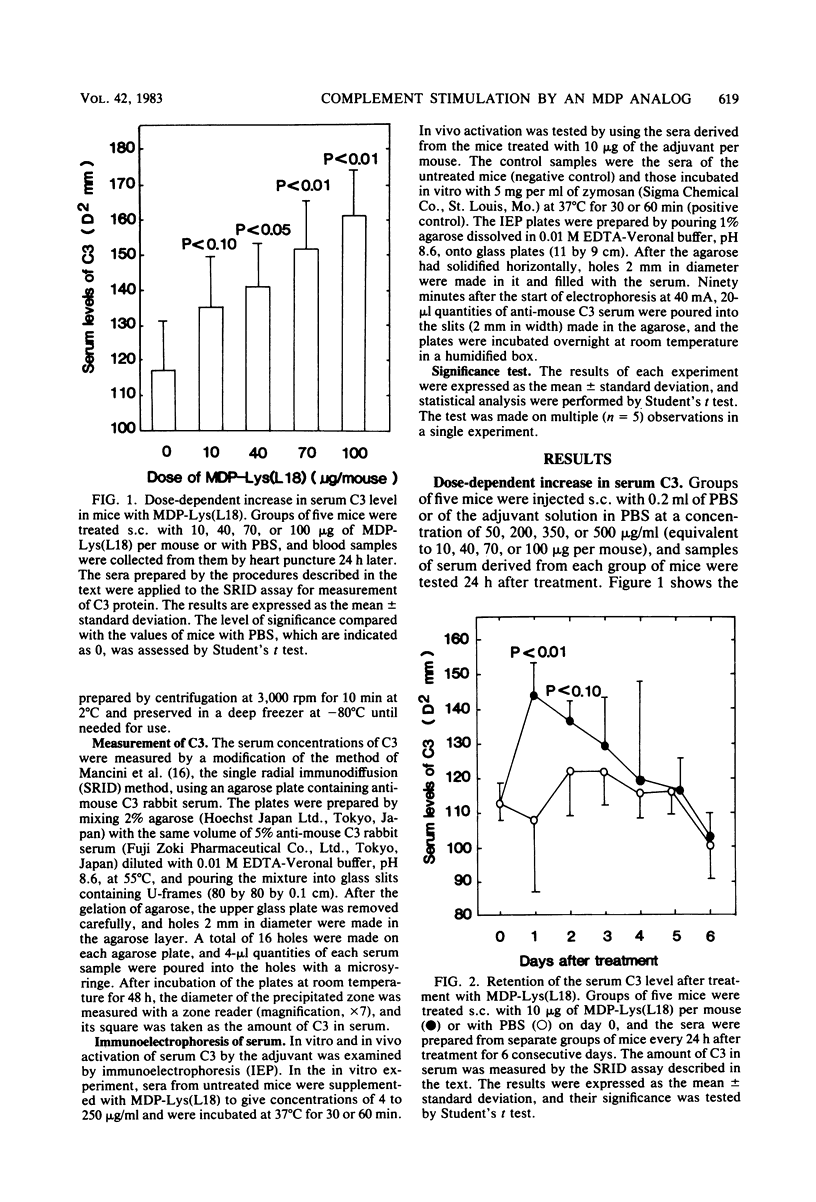
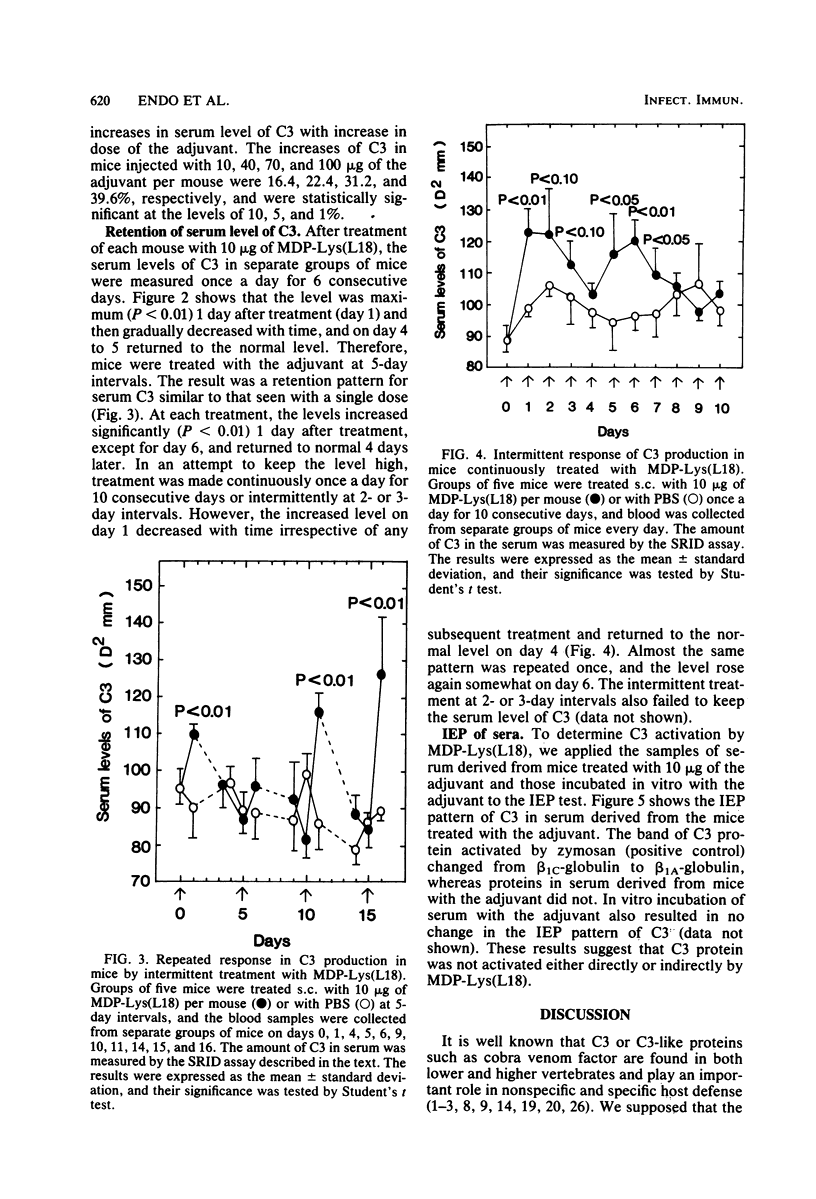
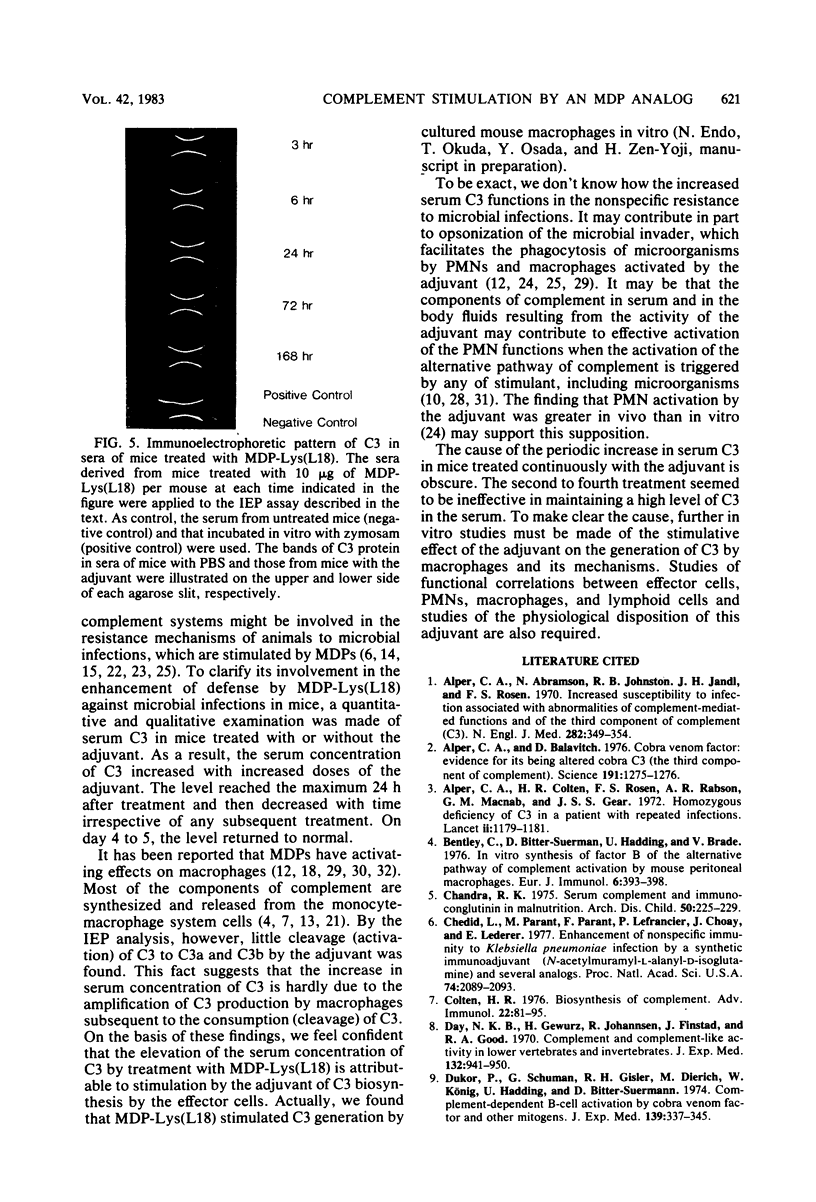
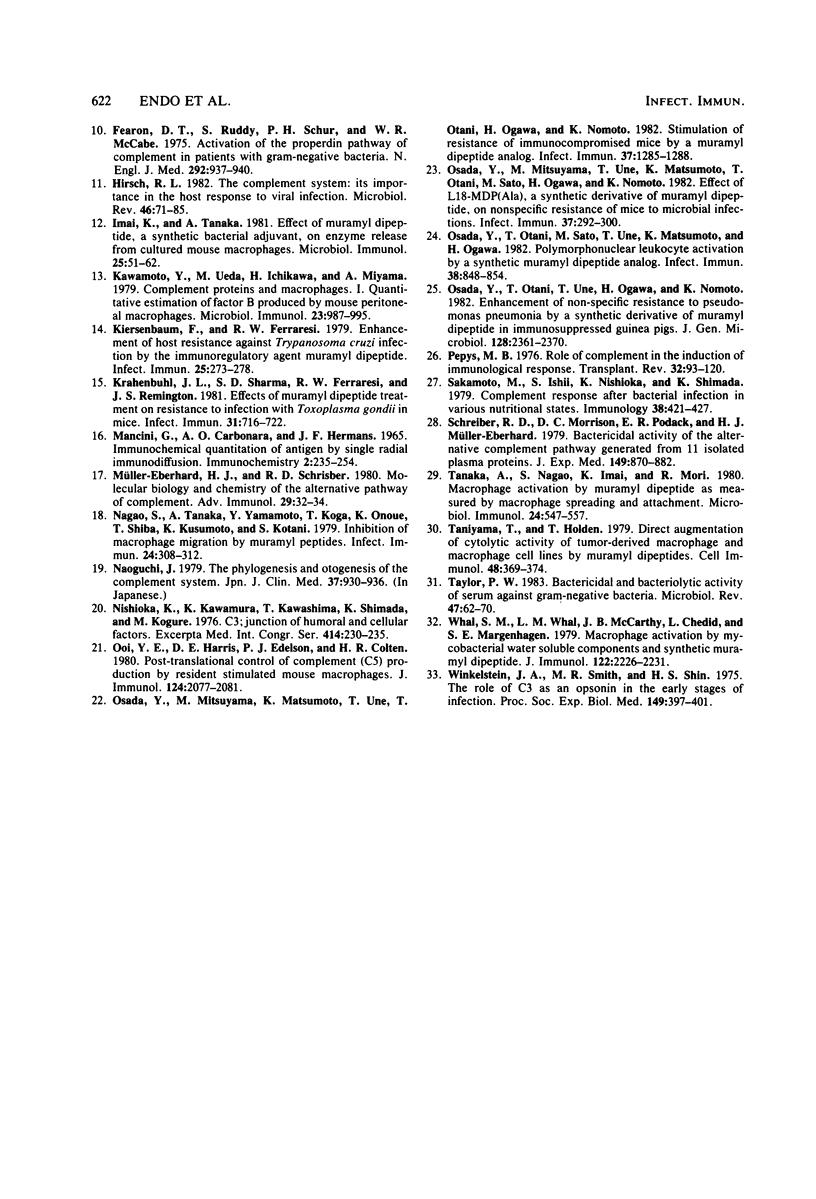
Images in this article
Selected References
These references are in PubMed. This may not be the complete list of references from this article.
- Alper C. A., Abramson N., Johnston R. B., Jr, Jandl J. H., Rosen F. S. Increased susceptibility to infection associated with abnormalities of complement-mediated functions and of the third component of complement (C3). N Engl J Med. 1970 Feb 12;282(7):350–354. doi: 10.1056/nejm197002122820701. [DOI] [PubMed] [Google Scholar]
- Alper C. A., Balavitch D. Cobra venom factor: evidence for its being altered cobra C3 (the third component of complement). Science. 1976 Mar 26;191(4233):1275–1276. doi: 10.1126/science.56780. [DOI] [PubMed] [Google Scholar]
- Alper C. A., Colten H. R., Rosen F. S., Rabson A. R., Macnab G. M., Gear J. S. Homozygous deficiency of C3 in a patient with repeated infections. Lancet. 1972 Dec 2;2(7788):1179–1181. doi: 10.1016/s0140-6736(72)92598-6. [DOI] [PubMed] [Google Scholar]
- Bentley C., Bitter-Suermann D., Hadding U., Brade V. In vitro synthesis of factor B of the alternative pathway of complement activation by mouse peritoneal macrophages. Eur J Immunol. 1976 Jun;6(6):393–398. doi: 10.1002/eji.1830060604. [DOI] [PubMed] [Google Scholar]
- Chandra R. K. Serum complement and immunoconglutinin in malnutrition. Arch Dis Child. 1975 Mar;50(3):225–229. doi: 10.1136/adc.50.3.225. [DOI] [PMC free article] [PubMed] [Google Scholar]
- Chedid L., Parant M., Parant F., Lefrancher P., Choay J., Lederer E. Enhancement of nonspecific immunity to Klebsiella pneumoniae infection by a synthetic immunoadjuvant (N-acetylmuramyl-L-alanyl-D-isoglutamine) and several analogs. Proc Natl Acad Sci U S A. 1977 May;74(5):2089–2093. doi: 10.1073/pnas.74.5.2089. [DOI] [PMC free article] [PubMed] [Google Scholar]
- Day N. K., Gewurz H., Johannsen R., Finstad J., Good R. A. Complement and complement-like activity in lower vertebrates and invertebrates. J Exp Med. 1970 Nov;132(5):941–950. doi: 10.1084/jem.132.5.941. [DOI] [PMC free article] [PubMed] [Google Scholar]
- Dukor P., Schumann G., Gisler R. H., Dierich M., König W., Hadding U., Bitter-Suermann D. Complement-dependent B-cell activation by cobra venom factor and other mitogens? J Exp Med. 1974 Feb 1;139(2):337–354. doi: 10.1084/jem.139.2.337. [DOI] [PMC free article] [PubMed] [Google Scholar]
- Fearon D. T., Ruddy S., Schur P. H., McCabe W. R. Activation of the properdin pathway of complement in patients with gram-negative of bacteremia. N Engl J Med. 1975 May 1;292(18):937–940. doi: 10.1056/NEJM197505012921802. [DOI] [PubMed] [Google Scholar]
- Hirsch R. L. The complement system: its importance in the host response to viral infection. Microbiol Rev. 1982 Mar;46(1):71–85. doi: 10.1128/mr.46.1.71-85.1982. [DOI] [PMC free article] [PubMed] [Google Scholar]
- Imai K., Tanaka A. Effect of muramyldipeptide, a synthetic bacterial adjuvant, on enzyme release from cultured mouse macrophages. Microbiol Immunol. 1981;25(1):51–62. doi: 10.1111/j.1348-0421.1981.tb00006.x. [DOI] [PubMed] [Google Scholar]
- Kawamoto Y., Ueda M., Ichikawa H., Miyama A. Complement proteins and macrophages. 1. Quantitative estimation of factor B produced by mouse peritoneal macrophages. Microbiol Immunol. 1979;23(10):987–995. doi: 10.1111/j.1348-0421.1979.tb00529.x. [DOI] [PubMed] [Google Scholar]
- Kireszenbaum F., Ferraresi R. W. Enhancement of host resistance against Trypanosoma cruzi infection by the immunoregulatory agent muramyl dipeptide. Infect Immun. 1979 Jul;25(1):273–278. doi: 10.1128/iai.25.1.273-278.1979. [DOI] [PMC free article] [PubMed] [Google Scholar]
- Krahenbuhl J. L., Sharma S. D., Ferraresi R. W., Remington J. S. Effects of muramyl dipeptide treatment on resistance to infection with Toxoplasma gondii in mice. Infect Immun. 1981 Feb;31(2):716–722. doi: 10.1128/iai.31.2.716-722.1981. [DOI] [PMC free article] [PubMed] [Google Scholar]
- Mancini G., Carbonara A. O., Heremans J. F. Immunochemical quantitation of antigens by single radial immunodiffusion. Immunochemistry. 1965 Sep;2(3):235–254. doi: 10.1016/0019-2791(65)90004-2. [DOI] [PubMed] [Google Scholar]
- Nagao S., Tanaka A., Yamamoto Y., Koga T., Onoue K., Shiba T., Kusumoto K., Kotani S. Inhibition of macrophage migration by muramyl peptides. Infect Immun. 1979 May;24(2):308–312. doi: 10.1128/iai.24.2.308-312.1979. [DOI] [PMC free article] [PubMed] [Google Scholar]
- Ooi Y. M., Harris D. E., Edelson P. J., Colten H. R. Post-translational control of complement (C5) production by resident and stimulated mouse macrophages. J Immunol. 1980 May;124(5):2077–2081. [PubMed] [Google Scholar]
- Osada Y., Mitsuyama M., Matsumoto K., Une T., Otani T., Ogawa H., Nomoto K. Stimulation of resistance of immunocompromised mice by a muramyl dipeptide analog. Infect Immun. 1982 Sep;37(3):1285–1288. doi: 10.1128/iai.37.3.1285-1288.1982. [DOI] [PMC free article] [PubMed] [Google Scholar]
- Osada Y., Mitsuyama M., Une T., Matsumoto K., Otani T., Satoh M., Ogawa H., Nomoto K. Effect of L18-MDP(Ala), a synthetic derivative of muramyl dipeptide, on nonspecific resistance of mice to microbial infections. Infect Immun. 1982 Jul;37(1):292–300. doi: 10.1128/iai.37.1.292-300.1982. [DOI] [PMC free article] [PubMed] [Google Scholar]
- Osada Y., Ohtani T., Une T., Ogawa H., Nomoto K. Enhancement of non-specific resistance to Pseudomonas pneumonia by a synthetic derivative of muramoyl dipeptide in immunosuppressed guinea pigs. J Gen Microbiol. 1982 Oct;128(10):2361–2370. doi: 10.1099/00221287-128-10-2361. [DOI] [PubMed] [Google Scholar]
- Osada Y., Otani T., Sato M., Une T., Matsumoto K., Ogawa H. Polymorphonuclear leukocyte activation by a synthetic muramyl dipeptide analog. Infect Immun. 1982 Dec;38(3):848–854. doi: 10.1128/iai.38.3.848-854.1982. [DOI] [PMC free article] [PubMed] [Google Scholar]
- Pepys M. B. Role of complement in the induction of immunological responses. Transplant Rev. 1976;32:93–120. doi: 10.1111/j.1600-065x.1976.tb00230.x. [DOI] [PubMed] [Google Scholar]
- Sakamoto M., Ishii S., Nishioka K., Shimada K. Complement response after experimental bacterial infection in various nutritional states. Immunology. 1979 Oct;38(2):421–427. [PMC free article] [PubMed] [Google Scholar]
- Schreiber R. D., Morrison D. C., Podack E. R., Müller-Eberhard H. J. Bactericidal activity of the alternative complement pathway generated from 11 isolated plasma proteins. J Exp Med. 1979 Apr 1;149(4):870–882. doi: 10.1084/jem.149.4.870. [DOI] [PMC free article] [PubMed] [Google Scholar]
- Tanaka A., Nagao S., Imai K., Mori R. Macrophage activation by muramyl dipeptide as measured by macrophage spreading and attachment. Microbiol Immunol. 1980;24(6):547–557. doi: 10.1111/j.1348-0421.1980.tb02858.x. [DOI] [PubMed] [Google Scholar]
- Taniyama T., Holden H. T. Direct augmentation of cytolytic activity of tumor-derived macrophages and macrophage cell lines by muramyl dipeptide. Cell Immunol. 1979 Dec;48(2):369–374. doi: 10.1016/0008-8749(79)90131-x. [DOI] [PubMed] [Google Scholar]
- Wahl S. M., Wahl L. M., McCarthy J. B., Chedid L., Mergenhagen S. E. Macrophage activation by mycobacterial water soluble compounds and synthetic muramyl dipeptide. J Immunol. 1979 Jun;122(6):2226–2231. [PubMed] [Google Scholar]
- Winkelstein J. A., Smith M. R., Shin H. S. The role of C3 as an opsonin in the early stages of infection. Proc Soc Exp Biol Med. 1975 Jun;149(2):397–401. doi: 10.3181/00379727-149-38815. [DOI] [PubMed] [Google Scholar]



